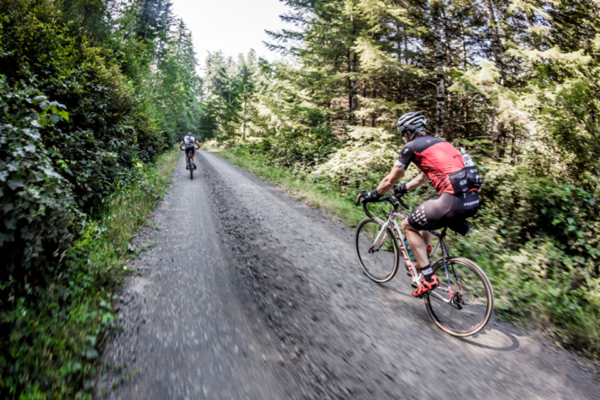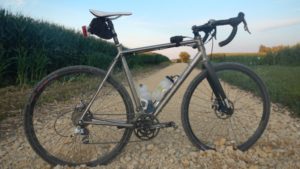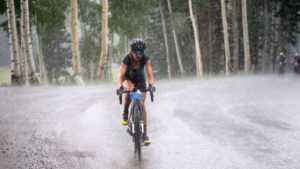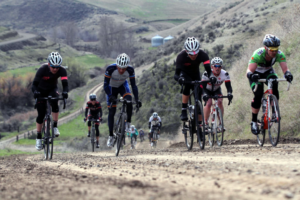It can be easy to get stuck in a cycling rut, riding the same routes over and over. Some consistency can be nice. It helps you get into a routine, but it never hurts to try something new. This year could be the year you take the rougher roads and check out some new scenery. Riding dirt and gravel roads expands your horizons, and can be a lot more fun than you think. You may have heard the term “gravel grinder” being thrown around – here’s what you need to know before jumping in wheel first.

What is a Gravel Grinder?
First things first, what is a gravel grinder? A gravel grinder is a race or ride that typically combines riding on a variety of surfaces including asphalt, gravel, dirt, and even some single track. As this niche has become increasingly popular over the last couple years, there are a ton of events to choose from. Distances vary from 50 – 150+ miles, and the routes themselves from hard packed dirt roads to rocky and rough terrain. Think of it as the bridge between mountain biking and road biking. It gets you off main roads, into the wilderness (in most cases), but doesn’t require a ton of commitment in the form of equipment.
 Step 1: The Gear
Step 1: The Gear
Although there are a ton of gravel specific bikes available, you don’t necessarily have to get one to give gravel a try. These bikes are similar to cyclocross bikes, but with geometry similar to touring and mountain bikes. Think less twitch and more stability to get you over those rough patches.
If you already own a cyclocross bike, then that will be the closest thing to a gravel bike. However, you can make a road or mountain bike work as well. The compromise with a road or cyclocross bike will be related to tire selection. With mountain bikes it will be the aerodynamic drag. That being said, having a bike you’re used to riding and are comfortable with can make your ride a whole lot easier. Lots of riders do gravel grinders on mountain or even fat bikes, although doing so will most likely take you out of the running from a race standpoint.
Step 2: Be Prepared

Flats
Your choice of tire will depend on the event or ride that you’re hoping to do. For most gravel grinders you’ll find a 700×38 or 700×42 semi-slick tubeless tire will be best. Regardless of the condition of the dirt road you must be prepared to flat. The best preventative is riding tubeless where there’s no risk of pinch flatting and the sealant inside the tire quickly fills any small punctures. And then if you flat you simply install a traditional tube. If you are running a tube, make sure you put an extra five or so psi in the tire to help prevent pinch flats, but this will make for a rougher ride. With riding gravel you should also bring a couple spare tubes as well as a patch kit.
Water Bottle Cage
One thing that is not often thought about when riding gravel is that it is much more likely for your water bottles to eject from your cages. If you haven’t planned ahead, take a big swig out of both bottles so they are not full as well as leaving the pop-up top open. This will cause the bottle to become slightly less rigid and have a lower chance of flying out. If you plan on riding dirt on a regular basis, invest in a few water bottles that are softer and easier to squeeze. The cheap, hard bottles are easily ejected. If you have standard metal cages you should bend them in slightly. You will have to pull a bit harder to get the bottle out when you want a drink but it will keep your bottles firmly secure.
Clothing
You’ll want to dress in a way that you can adapt to ever-changing conditions. If the race is in the spring or fall, then you definitely need to layer up so you can take whatever comes in stride. Depending on the length of the race, you’ll also need adequate food and water. You could carry this in a backpack, but the weight on your back could get tiresome 80 miles in. A frame bag could be a great investment to carry those must-have supplies.
Step 3: Train
Long Rides
Training for a gravel grinder event is more often about becoming accustomed to long distances and riding rough roads then it is about speed or pure fitness. The most important thing here is that you are comfortable on your bike. The appeal of these events is the adventure of it, so start preparing mentally for a variety of terrains. Some will be a ton of fun, others…not so much. It will also take you much longer to cover certain distances on gravel then it would on pavement. If you’ve never ridden gravel before, then you’ll want to put in some serious miles on rougher roads to get a feel for the handling of the bike and to hone in your technique.
Hill Work
Climbs are tough enough on pavement, so add in the element of loose gravel and your muscles will need to be ready to make it through. Do plenty of hill work in your training rides to build up those climbing muscles. That way you’ll have plenty of power when it comes to the race.
Navigation
Navigation can be an aspect of gravel grinders that will intimidate first-timers, but it’s not that hard once you have a system down. Most race organizers use cue sheets to navigate riders, which you have to carry with you and, more importantly, understand before you head out. These cues are organized by mileage, so you’ll need an accurate cycling computer or GPS to stay on track.
Riding gravel can be one of the best ways to have fun on the bike, but you can also get stuck starting at the road for miles on end as you’re trying to avoid other riders and obstacles on the road. As you get more comfortable, remember to lift your head up, look around, and enjoy the ride!